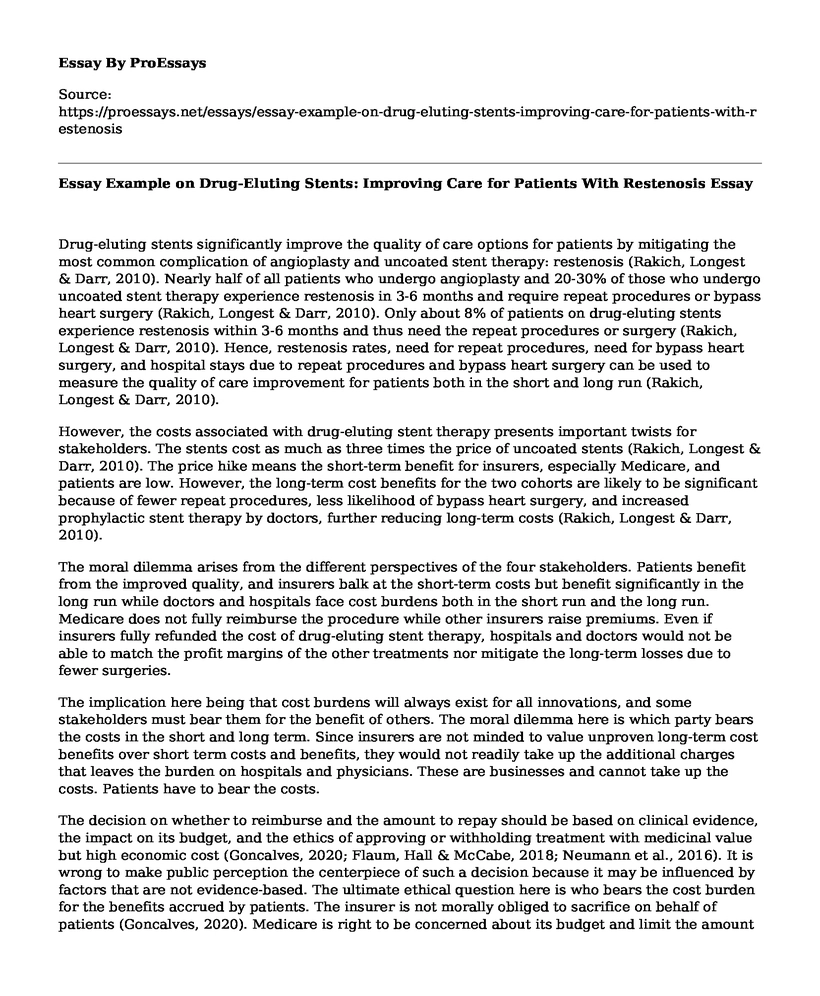Drug-eluting stents significantly improve the quality of care options for patients by mitigating the most common complication of angioplasty and uncoated stent therapy: restenosis (Rakich, Longest & Darr, 2010). Nearly half of all patients who undergo angioplasty and 20-30% of those who undergo uncoated stent therapy experience restenosis in 3-6 months and require repeat procedures or bypass heart surgery (Rakich, Longest & Darr, 2010). Only about 8% of patients on drug-eluting stents experience restenosis within 3-6 months and thus need the repeat procedures or surgery (Rakich, Longest & Darr, 2010). Hence, restenosis rates, need for repeat procedures, need for bypass heart surgery, and hospital stays due to repeat procedures and bypass heart surgery can be used to measure the quality of care improvement for patients both in the short and long run (Rakich, Longest & Darr, 2010).
However, the costs associated with drug-eluting stent therapy presents important twists for stakeholders. The stents cost as much as three times the price of uncoated stents (Rakich, Longest & Darr, 2010). The price hike means the short-term benefit for insurers, especially Medicare, and patients are low. However, the long-term cost benefits for the two cohorts are likely to be significant because of fewer repeat procedures, less likelihood of bypass heart surgery, and increased prophylactic stent therapy by doctors, further reducing long-term costs (Rakich, Longest & Darr, 2010).
The moral dilemma arises from the different perspectives of the four stakeholders. Patients benefit from the improved quality, and insurers balk at the short-term costs but benefit significantly in the long run while doctors and hospitals face cost burdens both in the short run and the long run. Medicare does not fully reimburse the procedure while other insurers raise premiums. Even if insurers fully refunded the cost of drug-eluting stent therapy, hospitals and doctors would not be able to match the profit margins of the other treatments nor mitigate the long-term losses due to fewer surgeries.
The implication here being that cost burdens will always exist for all innovations, and some stakeholders must bear them for the benefit of others. The moral dilemma here is which party bears the costs in the short and long term. Since insurers are not minded to value unproven long-term cost benefits over short term costs and benefits, they would not readily take up the additional charges that leaves the burden on hospitals and physicians. These are businesses and cannot take up the costs. Patients have to bear the costs.
The decision on whether to reimburse and the amount to repay should be based on clinical evidence, the impact on its budget, and the ethics of approving or withholding treatment with medicinal value but high economic cost (Goncalves, 2020; Flaum, Hall & McCabe, 2018; Neumann et al., 2016). It is wrong to make public perception the centerpiece of such a decision because it may be influenced by factors that are not evidence-based. The ultimate ethical question here is who bears the cost burden for the benefits accrued by patients. The insurer is not morally obliged to sacrifice on behalf of patients (Goncalves, 2020). Medicare is right to be concerned about its budget and limit the amount of reimbursement for the drug. However, it is also ethically wrong for hospitals, which are businesses, to bear the direct cost of the drug-eluting stent therapy due to low reimbursements (Rutstein et al., 2017). Finally, it would also be morally wrong to deny patients the option of the new treatment to preserve the long-term profits of doctors and hospitals. The loss of revenues due to surgeries and repeat procedures should have no bearing on this decision.
The prudent course of action here would be to ask patients to co-pay with the insurer for the procedure if they chose it (Goncalves, 2020; Flaum, Hall & McCabe, 2018). Ethical concerns about equity and redistributive justice may arise in such a case (Brock et al., 2017). However, such arguments fail because ethics do not require one party to sacrifice heavily on behalf of another. In a capitalist society, a financial burden is a significant sacrifice that should only be imposed collectively on not at all.
References
Brock, D. W., Daniels, N., Neumann, P. J., & Siegel, J. E. (2017). Ethical and distributive considerations. In Panel on Cost-Effectiveness in Health and Medicine (pp. 319-327). Oxford University Press, New York.
Flaum, N., Hall, P., & McCabe, C. (2018). Balancing the Economics and Ethics of Personalised Oncology. Trends in Cancer, 4(9), 608-615. Retrieved on February 19 2020 from https://www.sciencedirect.com/science/article/pii/S2405803318301729
Goncalves, E. (2020). Advanced therapy medicinal products: value judgement and ethical evaluation in health technology assessment. Springer. 20 (1). Retrieved on February 19 2020 from https://link.springer.com/article/10.1007/s10198-019-01147-x
Neumann, P. J., Sanders, G. D., Russell, L. B., Siegel, J. E., & Ganiats, T. G. (Eds.). (2016). Cost-effectiveness in health and medicine. Oxford University Press.
Rakich, J. S., Longest, B. B., & Darr, K. (2010). Cases in health services management (5th ed.). Baltimore, MD: Health Professions Press.
Reinhardt, U. E. (2019). Priced Out: The Economic and Ethical Costs of American Health Care. Princeton University Press.
Rutstein, S. E., Price, J. T., Rosenberg, N. E., Rennie, S. M., Biddle, A. K., & Miller, W. C. (2017). Hidden costs: the ethics of cost-effectiveness analyses for health interventions in resource-limited settings. Global Public Health, 12(10), 1269-1281. Retrieved on February 19 2020 from https://www.tandfonline.com/doi/abs/10.1080/17441692.2016.1178319
Cite this page
Essay Example on Drug-Eluting Stents: Improving Care for Patients With Restenosis. (2023, Apr 08). Retrieved from https://proessays.net/essays/essay-example-on-drug-eluting-stents-improving-care-for-patients-with-restenosis
If you are the original author of this essay and no longer wish to have it published on the ProEssays website, please click below to request its removal:
- Dental Hygiene: Preventive Counselling Competency
- Personal Statement for Nursing School
- Image of Nursing Essay Example
- Management of Postoperative Pain in Adult Surgical Patients Essay
- Distress and Depression in Diabetic Persons and Their Relationship With Self-Care Practitioners in Barbados
- Essay Sample on Healthcare Revenue Cycle Management
- Essay Example on Nursing Assessments for School-Age Children (5-12 yrs)







